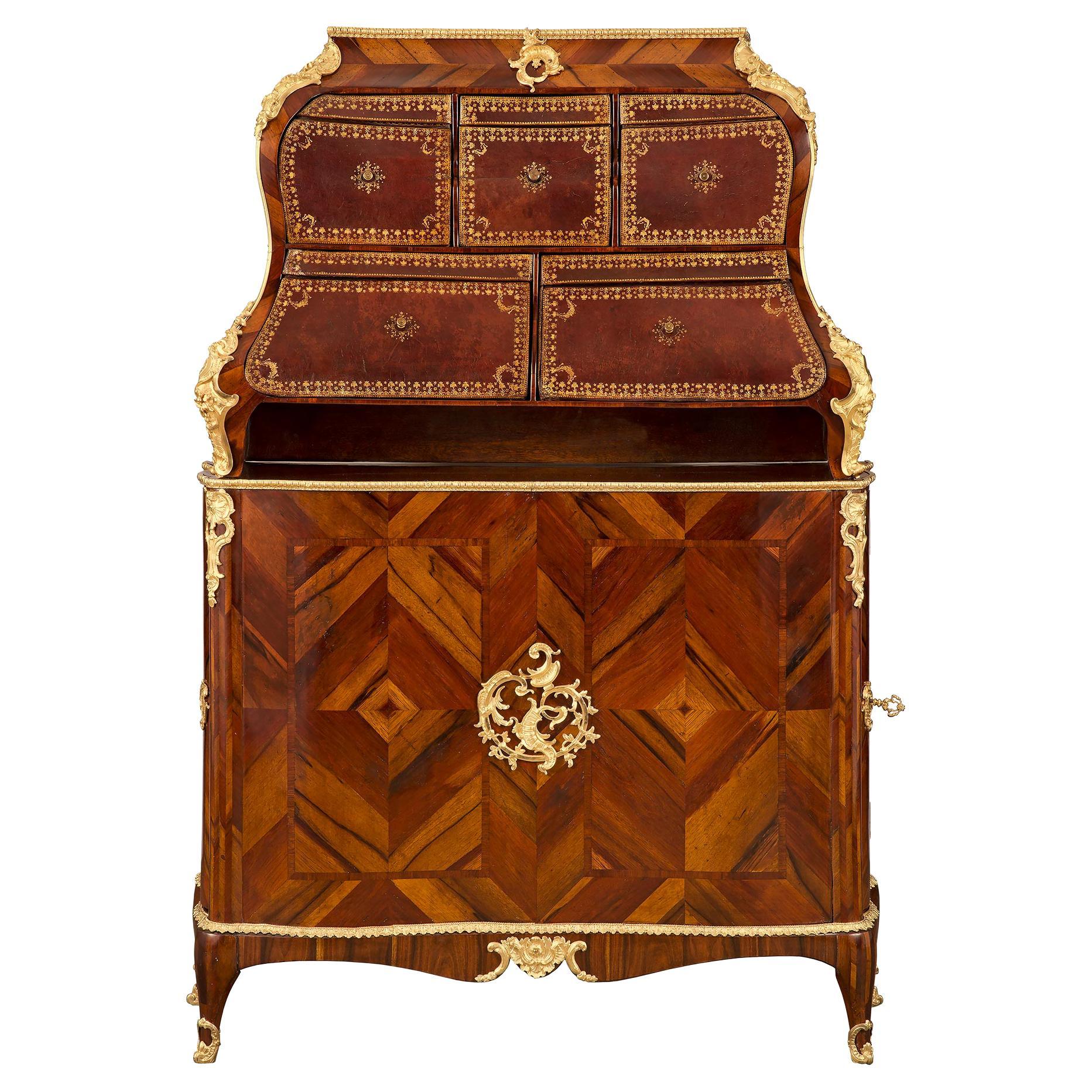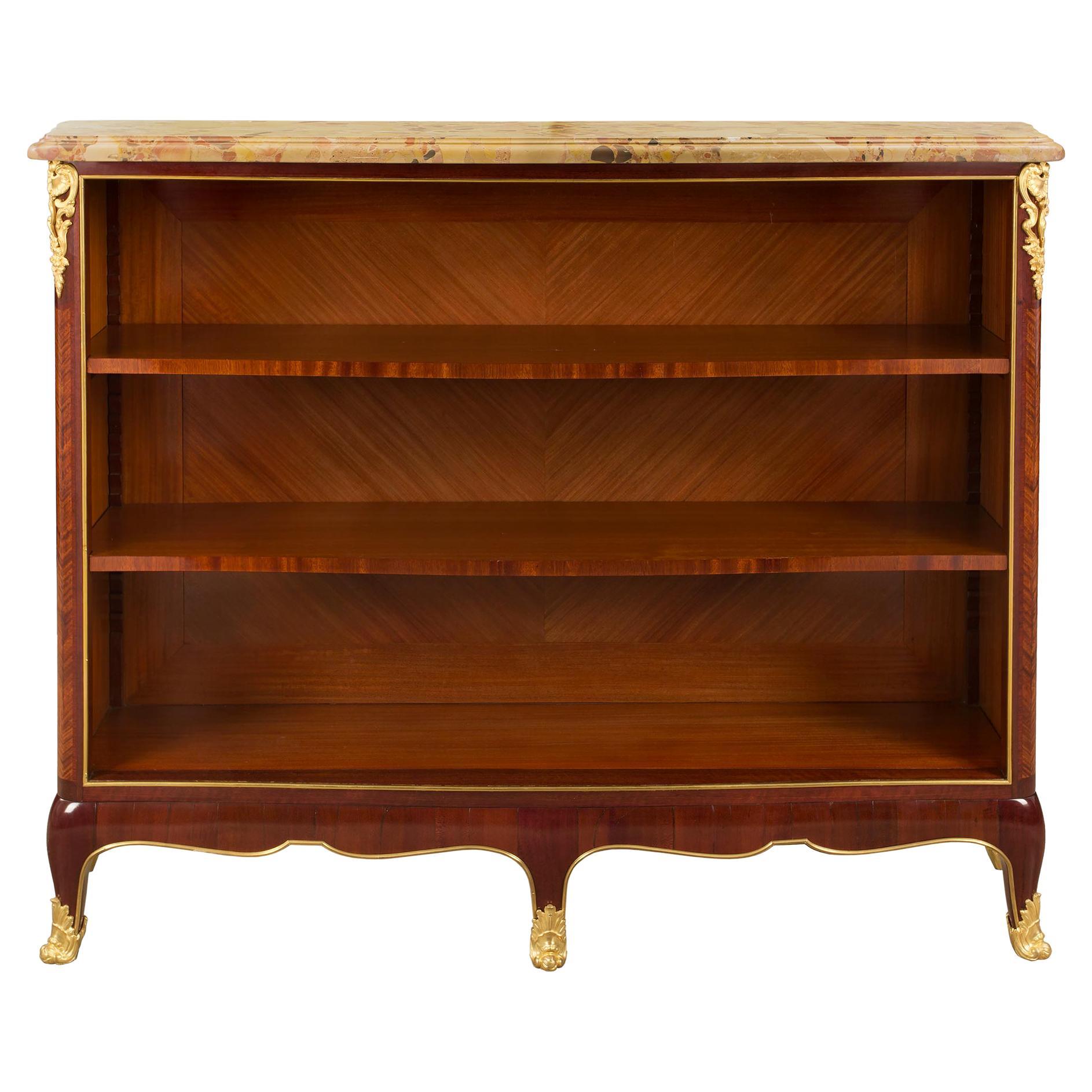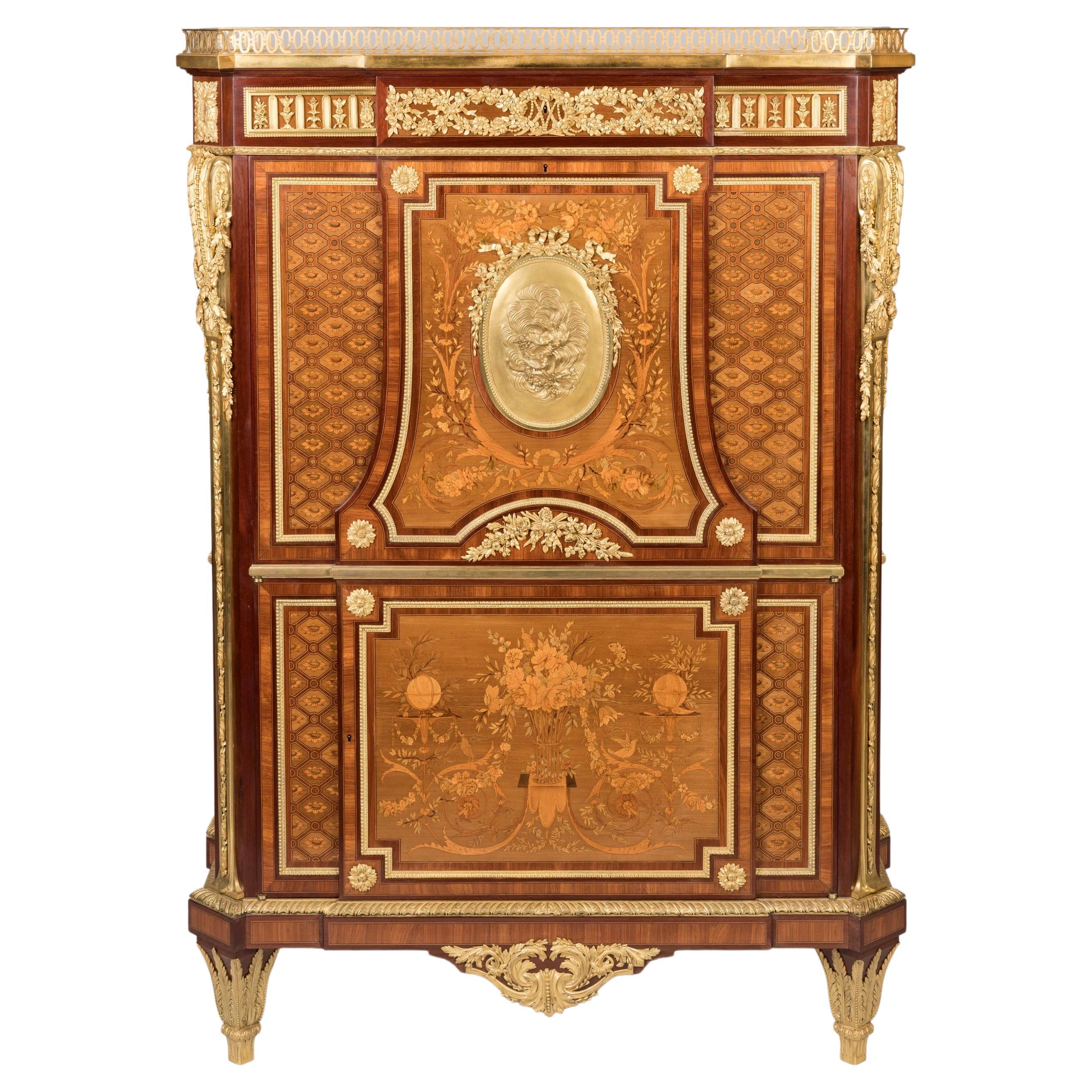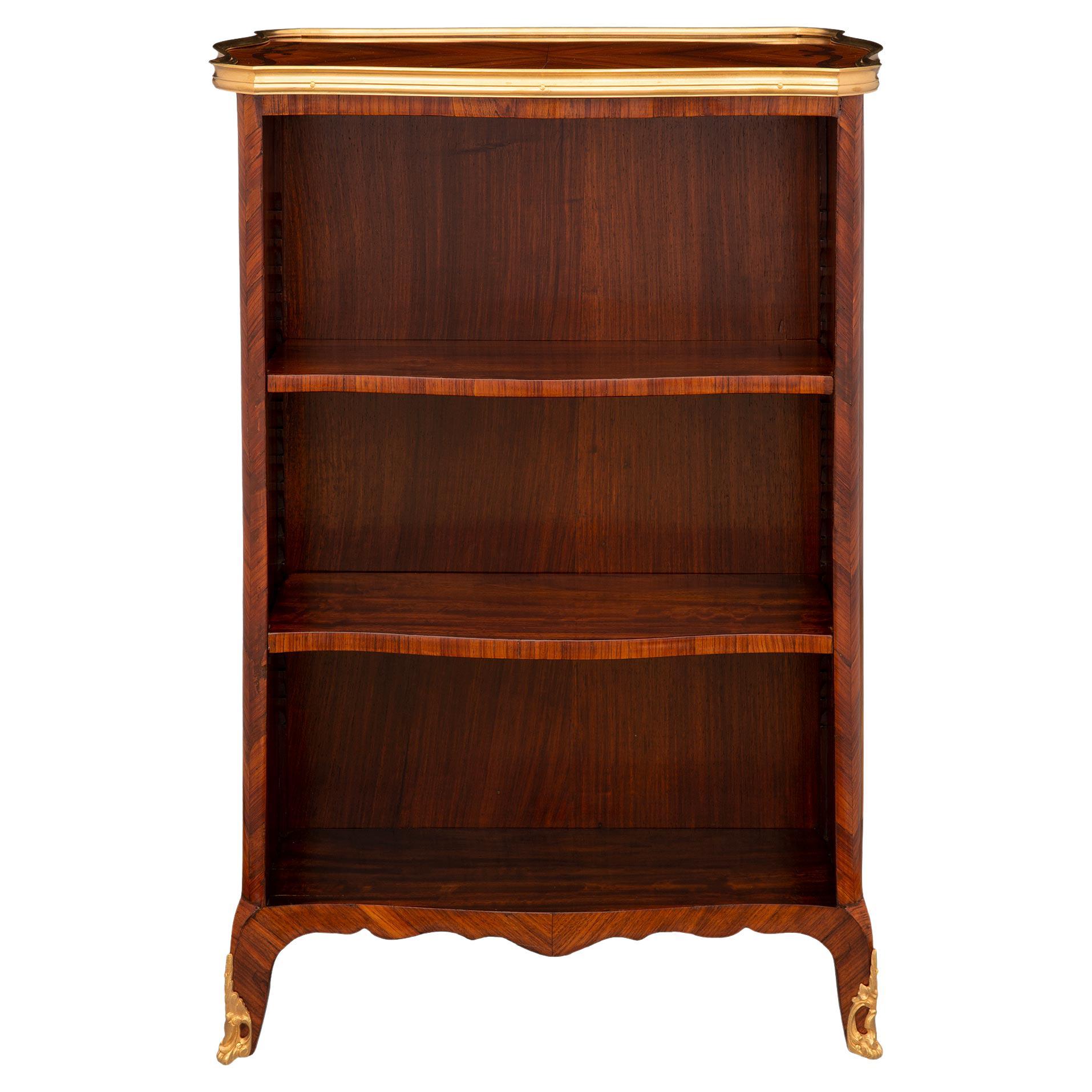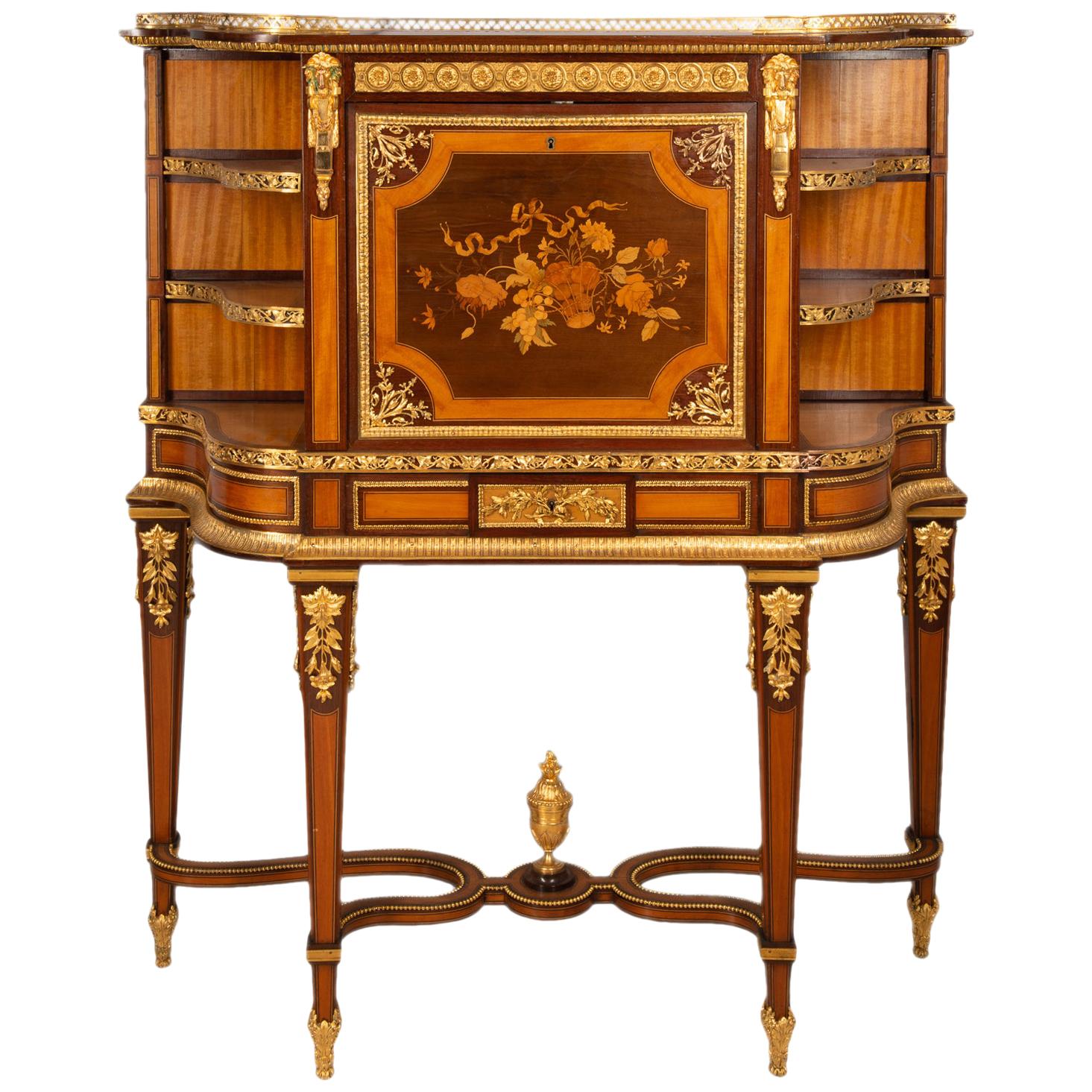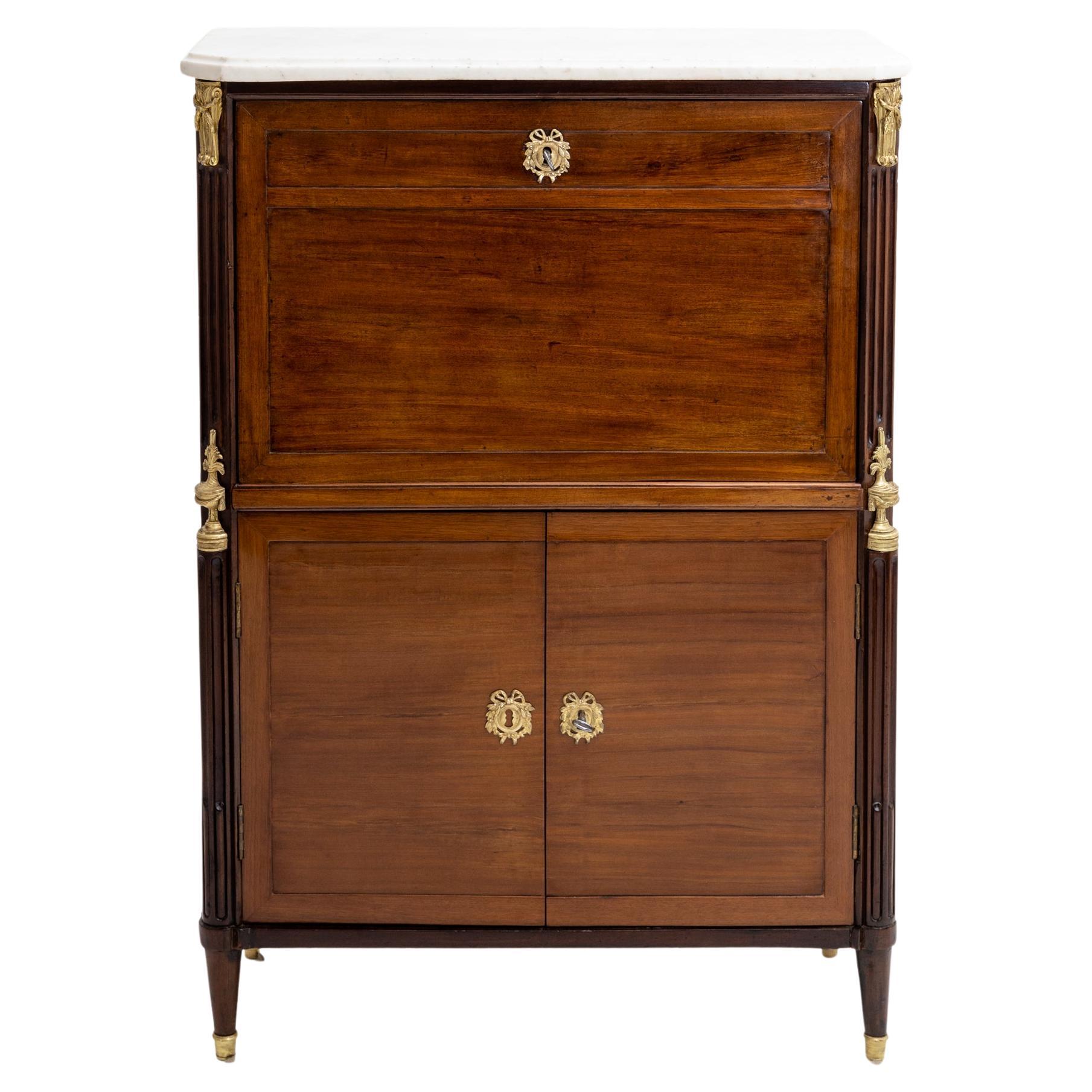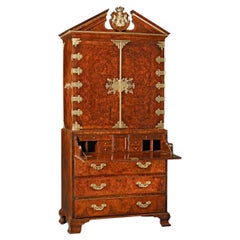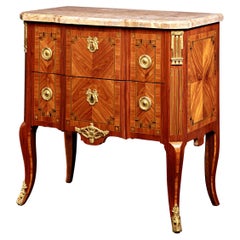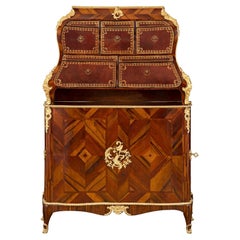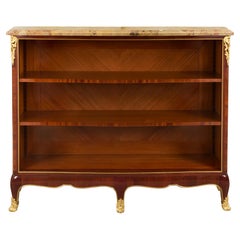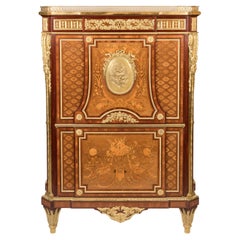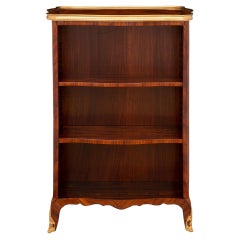Items Similar to 19th Century French Secrétaire by Durand
Want more images or videos?
Request additional images or videos from the seller
1 of 5
19th Century French Secrétaire by Durand
$29,850
£22,649.49
€25,897.67
CA$41,692.36
A$46,356.23
CHF 24,204.66
MX$564,268.16
NOK 308,840.97
SEK 289,369.23
DKK 193,279.08
Shipping
Retrieving quote...The 1stDibs Promise:
Authenticity Guarantee,
Money-Back Guarantee,
24-Hour Cancellation
About the Item
Superior craftsmanship and intricate marquetry characterize this rare secrétaire by Gervais-Maximilien-Eugène Durand, one of the most popular French ébénistes of the 19th century. This is an exceptional example of his work, bringing together beautiful materials and a practical, yet elegant design. The compact Louis XV-inspired form features two visible shelves, as well as two others cleverly hidden by a false front at the base. Beautifully embellished with Durand's distinctive Rococo-style ormolu mounts, the secrétaire rests on four curved feet enveloped by ornamented bronze.
Celebrated as one of the greatest ébénistes of luxury furniture at the turn of the century, Durand was a master at creating original designs inspired by the Louis XV and Rococo styles. He established the firm of Maison Durand in 1870, and he soon thereafter received international recognition when the maison triumphed at the 1889 Paris Exposition Universelle. Today, high-quality, signed examples such as this are becoming increasingly scarce finds.
Stamped "G. Durand"
circa 1880
Measures: 46 1/8" high x 24" wide x 11" deep.
- Creator:Gervais Durand (Maker)
- Dimensions:Height: 46.13 in (117.18 cm)Width: 24 in (60.96 cm)Depth: 11 in (27.94 cm)
- Style:Louis XV (In the Style Of)
- Materials and Techniques:
- Place of Origin:
- Period:
- Date of Manufacture:circa 1880
- Condition:
- Seller Location:New Orleans, LA
- Reference Number:Seller: 30-79861stDibs: LU891111705241
About the Seller
5.0
Recognized Seller
These prestigious sellers are industry leaders and represent the highest echelon for item quality and design.
Established in 1912
1stDibs seller since 2010
109 sales on 1stDibs
Typical response time: 4 hours
- ShippingRetrieving quote...Shipping from: New Orleans, LA
- Return Policy
Authenticity Guarantee
In the unlikely event there’s an issue with an item’s authenticity, contact us within 1 year for a full refund. DetailsMoney-Back Guarantee
If your item is not as described, is damaged in transit, or does not arrive, contact us within 7 days for a full refund. Details24-Hour Cancellation
You have a 24-hour grace period in which to reconsider your purchase, with no questions asked.Vetted Professional Sellers
Our world-class sellers must adhere to strict standards for service and quality, maintaining the integrity of our listings.Price-Match Guarantee
If you find that a seller listed the same item for a lower price elsewhere, we’ll match it.Trusted Global Delivery
Our best-in-class carrier network provides specialized shipping options worldwide, including custom delivery.More From This Seller
View All19th Century French Vitrine by Francois Linke
By François Linke
Located in New Orleans, LA
This rare and stunning vitrine was crafted by the illustrious French ébéniste François Linke. A master of the Louis XVI style, Linke was renowned for his highly original designs t...
Category
Antique 19th Century French Rococo Vitrines
Materials
Bronze
King George I Ambassadorial Secrétaire-Cabinet
Located in New Orleans, LA
This highly important secrétaire-cabinet was crafted for and specially ordered by King George I for the British Ambassador to Russia. From its craftsmanship and materials to its exceptional artistry, it is a work of royal and historic significance that exudes power in each and every detail. The broken pediment at its apex features the simplified royal coat of arms bearing the king’s crown, while the interior is adorned by portraits of the British Royal Family. Placed within the ambassador’s St. Petersburg home, this entirely unique piece of furniture would have been a potent reminder of England's grandeur and political importance.
Relations between England and Russia during this period were at an all-time high. Peter the Great had traveled to England in 1698 as part of his widely known “Grand Embassy” tour, wherein he attempted to gain foreign support against the Ottoman Empire. He spent a period of nearly four months there, meeting with King William III and his court on numerous occasions. Noted academic Arthur MacGregor wrote concerning the impact of the trip, “For two decades following Peter's visit, British influence in Russia reached a peak. It manifested itself in social custom, in craft practice and in ships and naval organization... it reached a significant sector of the population before relations cooled once again and the two nations pulled back from this era of unprecedented cordiality.”
First and foremost, however, it is a reminder of British might and influence. By the reign of King George I, England had come into its own as a world power. Unique in its design, this cabinet is a reflection of the country’s might. It is crafted from the highest-quality solid walnut and burr walnut adorned by gilded lock plates and engraved hinges. The presence of ormolu at its apex and lining the doors was a rarity for this period, and its addition makes manifest the importance of the design.
The outer doors open to reveal multiple interiors, including fifteen separate drawers around a central cupboard; the cupboard doors each bear mezzotint portraits of George I and his father, Ernest Augustus, Elector of Hanover. An etching after the portrait of George I dating to circa 1716 is in London’s Royal Academy. A second, inner pair of doors are adorned by mezzotints of the Prince and Princess of Wales (later Queen Caroline and George II), which are both after portraits by Sir Godfrey Kneller dated 1716 in the Royal Collection. A final portrait is revealed on the very interior of the cabinet, where a mezzotint of Frederick, Anne, Amelia and Caroline, children of the Prince of Wales, resides. An etching (circa 1715-1720) after this portrait can be found in the National Portrait Gallery (London).
Apart from its abundance of royal portraiture, the cabinet features stunning painted decoration, including floral designs as well as clouds, birds and trees in a bucolic motif reminiscent of Eden. Its lower portion is a study in both form and function, featuring a fitted secrétaire-drawer above three additional drawers for storage. The cabinet appears in The Shorter Dictionary of English Furniture by R. Edwards from 1964, a text that is regarded as the bible of British furniture design. Edwards describes it as a “writing cabinet...given by George I to the British Ambassador at the Russian court.”
The cabinet was likely made for the 18th-century German diplomat and writer Friedrich Christian Weber, who represented English interests at the Russian court from 1714 until 1719. Although Weber’s tenure as ambassador was relatively short, while in St. Petersburg, he authored his account entitled Das veraenderte Russland (The Present State of Russia), which was published in three volumes in 1721, 1739 and 1740. It may, however, also have been made for George Douglas, 2nd Earl of Dumbarton, who served as ambassador alongside Weber in 1716. Diplomatic relations ceased between the two countries in 1721.
In 1928, the cabinet appeared for sale at the International Exhibition of Antiques & Works of Art in Olympia. It had previously been in the collection of the Woltner family of Bordeaux, the celebrated vintners who owned the estate Château Laville Haut-Brion and produced wine of the same name. According to the family, Monsieur Woltner was given the cabinet as a gift from an aunt who lived in Russia for many years. After leaving the Woltner collection, the cabinet was acquired by William Berry...
Category
Antique 18th Century English Georgian Secretaires
Materials
Brass
Louis XIV Inspired French Linen Press
Located in New Orleans, LA
Enveloped in sumptuous parquetry and doré bronze, this majestic Louis XIV inspired French linen press displays the characteristics of superior craftsmanship and luxurious design seen in the creations of the iconic Françios Linke. Crafted of sumptuous kingwood, the glorious parquetry door opens to reveal six compartments used to store linens, such as those for the bedroom or even the dining table. The masterful woodwork is flawlessly balanced by intricate doré bronze mounts in the form of Neoclassical floral swags, garlands, plumes and acanthus scrolls. The delicately spiraled doré bronze feet give the cabinet a sense of lightness and balance. Enhanced by a beautiful rouge marble top, this elegant linen press is an excellent example of late 19th century French furniture...
Category
Antique 19th Century French Louis XIV Linen Presses
Materials
Bronze
Louis XVI Commode by Pierre Roussel
By Pierre Roussel
Located in New Orleans, LA
Matchless style and high-quality craftsmanship are the hallmarks of Pierre Roussel's furniture, and this exceptional Louis XVI-era commode epitomizes this master craftsman's skill. Crafted of rosewood veneer with a violet wood frame and intricate parquetry inlay, the cabinet's graceful design is also highly practical. The compact form holds two drawers, one of which can be locked for added security. A specimen of marble provides the perfect surface, while bronze ormolu mounts add an additional hint of luxury to the drawers and body. Elegantly curved cabriole legs with bronze ormolu shoes complete this impeccable piece.
Known for his superior craftsmanship, Roussel was a highly respected maître ébéniste of the 18th century. His furniture pieces were favoured by grand patrons such as the Prince de Condé and the Princess of Monaco...
Category
Antique 18th Century French Louis XVI Commodes and Chests of Drawers
Materials
Marble, Bronze
Louis XV Style Writing Desk by François Linke
By François Linke
Located in New Orleans, LA
Superior craftsmanship and elegant bronze work characterize this tambour front roll top writing desk by François Linke, the most important French ébéniste of his time. Linke is celeb...
Category
Antique Late 19th Century French Louis XV Desks
Materials
Bronze
Meuble Soleil Commode by François Linke
By François Linke
Located in New Orleans, LA
One of only three of its kind, this commode was crafted by the famed and highly celebrated ébéniste François Linke. Blending the stunning marquetry of the Louis XV and XVI styles with the elegance of Art Nouveau, the commode exemplifies Linke's skilled craftsmanship. Inspired by François Alix's iconic "Meuble Soleil" design, Linke's creation showcases his signature genius in every aspect of the commode's construction.
The superior quality of the breche marble shelves and top, marquetry and ormolu that form the undulating body of the cabinet serve as a testament to Linke’s unwavering dedication to perfection. The craftsman spared no expense, investing significant time and utilizing only the finest materials to create this work of art. Tens of thousands of hand-wrought chisel marks are visible within the ormolu frieze of scrolling foliage. The breathtaking marquetry landscape on the front is perhaps the commode's greatest feature, depicting a radiant sun bursting from behind trees, elegantly enhanced by Linke's unmistakable signature on the lower right molding and on the inside of the inner cabinets.
For Linke, winning the coveted Gold Medal at the 1900 Paris Exhibition Universelle confirmed his already solid reputation as France's leading ébéniste. His work had long been admired for its exceptional quality and unique interpretation of the Louis XV style. Born in Bohemia in 1855, Linke moved to Paris in 1881 where he established his now-famous workshop and showroom. Word of Linke's superior work spread quickly through France, and he soon eclipsed even the finest furniture houses in Paris. Today, Linke is counted among the most important furniture makers of the late 19th and early 20th centuries, and his work is dearly coveted by collectors.
As one of the most masterful furniture designers and bronziers of his time, François Alix would only supply designs and bronze pieces to the most skilled of his contemporaries. Linke chose this unique design personally and only produced three versions of this remarkable piece, with the first one crafted in 1910. A similar commode is housed in the Royal Collection Trust...
Category
Early 20th Century French Louis XV Commodes and Chests of Drawers
Materials
Marble, Ormolu
You May Also Like
French 18th Century Louis XV Period Cartonnier, Signed Jacques DuBois
By Jacques Dubois
Located in West Palm Beach, FL
A sensational French 18th century Louis XV Period kingwood, ormolu and leather Cartonnier, signed Jacques DuBois. This most decorative and extremely elegant Cartonnier is raised by h...
Category
Antique 18th Century French Louis XV Cabinets
Materials
Ormolu
French 19th Century Louis XV Style Tulipwood and Ormolu Bibus
By Frédéric & Gervais Durand
Located in West Palm Beach, FL
An elegant French 19th century Louis XV st. tulipwood and ormolu mounted Bibus, stamped F.Durand FILS. The Étagère is raised by Fine cabriole legs with beautiful wrap around ormolu s...
Category
Antique 19th Century French Louis XV Bookcases
Materials
Marble, Ormolu
Exceptionally Rare 19th Century French Secrétaire à Abattant by Paul Sormani
By Paul Sormani
Located in London, GB
An Exceptionally Rare Secrétaire à Abattant
After the designs of Jean-Henri Riesener for Marie Antoinette
By Paul Sormani of Paris
Of upright rectangular form with canted corners a...
Category
Antique 19th Century French Louis XVI Cabinets
Materials
Marble, Ormolu
French 19th Century Louis XV St. Kingwood And Ormolu Bibus
Located in West Palm Beach, FL
A striking French 19th century Louis XV st. kingwood and ormolu Bibus. The Bibus shelf is raised by elegant lightly curved legs with fine pierced ormolu sabots. Above the scalloped s...
Category
Antique 19th Century French Louis XV Cabinets
Materials
Ormolu
19th Century Louis XVI Style Secretaire Cabinet
Located in Brighton, Sussex
A fine quality 19th century French Louis XVI style satinwood marquetry inlaid secretaire cabinet, with wonderful inlaid decoration to the fall front, opening to reveal a fitted inter...
Category
Antique Late 19th Century French Secretaires
Materials
Satinwood
Louis Seize Secretaire à abattant, End of 18th Century
Located in Greding, DE
Secretaire with fluted pilasters and two-door bottom part and white marble shelf and fire-gilded fittings. Behind the writing flap with green leather there are more drawers and compa...
Category
Antique Late 18th Century European Louis XVI Secretaires
Materials
Marble
More Ways To Browse
Luxury Used Furniture
French 19th Century Masters
Antique Secretaire Furniture
Antique French Secretaire
French Marquetry Secretaire
G Durand
Century Furniture Secretary
Secretary Cabinets
Antique Secretary
Antique Secretaire Furniture
Secretary Furniture Antique
Secretary Desk With Cabinet
Secretaire Desk Antique
Antique Desks And Secretaries Desks And Secretaries
Antique Secretary Desks
Furniture With Hidden Compartments
Secretary Writing Desk
Pigeon Antique
